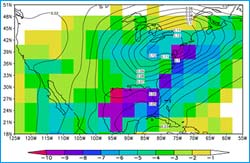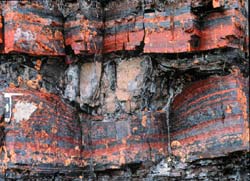
Across the world, rivers wash mountains into the sea. In the beautiful and rugged mountains of southeast Alaska, glaciers grind mountains down as fast as the earth’s colliding tectonic plates shove them up.
“Like an ice palace cheese grater, glaciers sweep and grind rocks off of mountains. No matter how fast the plate pushes the rock up, the glacier will erode it just as fast,” said James A. Spotila of Blacksburg, assistant professor of geosciences at Virginia Tech. The National Science
Earth’s climate system is more sensitive to perturbations now than it was in the distant past, according to a study published this week in the journal Nature. The findings suggest a previously unrecognized role for tropical and subtropical regions in controlling the sensitivity of the climate to change. Christina Ravelo, an ocean scientist at the University of California, Santa Cruz (UCSC) , and her coauthors at UCSC and Boise State University, Idaho, focused on the Pliocene epoch, from
Scientists working in the stormy and inhospitable waters off the Antarctic Peninsula have found what they believe is an active and previously unknown volcano on the sea bottom. The international science team from the United States and Canada mapped and sampled the ocean floor and collected video and data that indicate a major volcano exists on the Antarctic ontinental shelf, they announced on May 5 in a dispatch from the research vessel Laurence M. Gould, which is operated by the National Sc

the last four decades, scientists have observed a 1.3% per decade decline in the amount of sun reaching the Earth’s surface. This phenomenon, coined “solar dimming” or “global dimming,” is due to changes in clouds and air pollution that are impeding the suns ability to penetrate. Scientists believe that the combination of growing quantities of man-made aerosol particles in the atmosphere and more moisture are causing the cloud cover to thicken.
Despite this decline in solar radiation, the E

The 150-kilometre-per-hour winds of Typhoon Nida brought destruction and death to the Philippines this week. At least 31 people were killed and hundreds more were made homeless as the storm passed across the eastern part of the country on Wednesday.
Envisat acquired this image of the eye of the Typhoon on Tuesday 18 May, using its Medium Resolution Imaging Spectrometer (MERIS) in reduced resolution mode. The 1200-metre resolution image is some 1150 km wide.
The storm caused floods

NASA and the United States Geological Survey (USGS) are teaming up to create one of the most complete databases of magnetic properties of Earth’s rocks ever assembled. The partnership demonstrates ongoing interagency collaboration.
Satellite data of Earth’s magnetic field combined with rock magnetic data collected on the ground will provide more complete insight into Earth’s geology, gravity and magnetism.
Satellites, including NASA’s Magsat, have detected magnetic signals in the